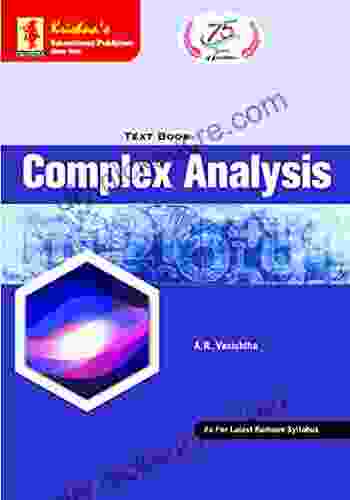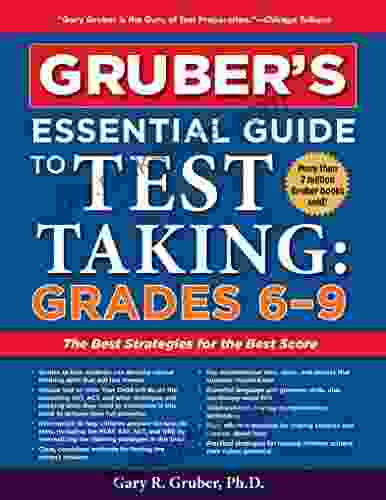TB Complex Analysis Edition 2b Pages 238 Code 1215 Concept Theorems Derivation

Complex analysis is a branch of mathematics that deals with functions of complex variables. It is a vast and important subject with applications in many areas of science and engineering. One of the most important concepts in complex analysis is the concept of a theorem. A theorem is a statement that has been proven to be true. Theorems are used to establish new results and to solve problems.
In this article, we will explore the concept of a theorem in complex analysis. We will provide a detailed explanation of the concept, as well as some examples and applications.
A theorem is a statement that has been proven to be true. Theorems are typically expressed in the form of an if-then statement. For example, the following statement is a theorem:
4.3 out of 5
| Language | : | English |
| File size | : | 5138 KB |
| Lending | : | Enabled |
| Screen Reader | : | Supported |
| Print length | : | 224 pages |
If a function is continuous on a closed interval, then it is bounded.
This theorem states that if a function is continuous on a closed interval, then there exists a number M such that |f(x)| ≤ M for all x in the interval.
Theorems are used to establish new results and to solve problems. For example, the theorem above can be used to prove that the following function is bounded:
f(x) = sin(x)
Since the sine function is continuous on the closed interval [-π, π], the theorem above implies that there exists a number M such that |sin(x)| ≤ M for all x in [-π, π].
Theorems are proven using a variety of techniques. Some of the most common techniques include:
- Direct proof: A direct proof shows that the of the theorem follows from the hypothesis. For example, the theorem above can be proven by showing that if a function is continuous on a closed interval, then there exists a number M such that |f(x)| ≤ M for all x in the interval.
- Proof by contradiction: A proof by contradiction shows that the negation of the of the theorem leads to a contradiction. For example, the theorem above can be proven by showing that if a function is not bounded, then it is not continuous on a closed interval.
- Mathematical induction: Mathematical induction is a technique that is used to prove statements about natural numbers. It is based on the principle that if a statement is true for a given natural number, then it is also true for the next natural number.
There are many important theorems in complex analysis. Some of the most famous theorems include:
- The Cauchy-Riemann equations: These equations are necessary and sufficient conditions for a function to be holomorphic.
- The Cauchy integral formula: This formula gives a representation for a holomorphic function in terms of its values on a closed contour.
- The residue theorem: This theorem gives a way to evaluate certain integrals by computing the residues of the integrand at its poles.
These are just a few of the many important theorems in complex analysis. Theorems are essential for the development of the subject and for its applications in other areas of mathematics and science.
Theorems in complex analysis have a wide range of applications in other areas of mathematics and science. Some of the most important applications include:
- Fluid mechanics: Complex analysis is used to study the flow of fluids. For example, the Cauchy-Riemann equations can be used to determine the velocity field of a fluid.
- Heat transfer: Complex analysis is used to study the transfer of heat. For example, the heat equation can be solved using complex analysis techniques.
- Electromagnetism: Complex analysis is used to study the behavior of electromagnetic fields. For example, the Maxwell equations can be solved using complex analysis techniques.
- Quantum mechanics: Complex analysis is used to study quantum mechanics. For example, the Schrödinger equation can be solved using complex analysis techniques.
These are just a few of the many applications of theorems in complex analysis. Theorems are essential for the development of many different areas of mathematics and science.
Theorems are an essential part of complex analysis. They are used to establish new results and to solve problems. In this article, we have provided a detailed explanation of the concept of a theorem, as well as some examples and applications. We hope that this article has given you a better understanding of the importance of theorems in complex analysis.
4.3 out of 5
| Language | : | English |
| File size | : | 5138 KB |
| Lending | : | Enabled |
| Screen Reader | : | Supported |
| Print length | : | 224 pages |
Do you want to contribute by writing guest posts on this blog?
Please contact us and send us a resume of previous articles that you have written.
 Fiction
Fiction Non Fiction
Non Fiction Romance
Romance Mystery
Mystery Thriller
Thriller SciFi
SciFi Fantasy
Fantasy Horror
Horror Biography
Biography Selfhelp
Selfhelp Business
Business History
History Classics
Classics Poetry
Poetry Childrens
Childrens Young Adult
Young Adult Educational
Educational Cooking
Cooking Travel
Travel Lifestyle
Lifestyle Spirituality
Spirituality Health
Health Fitness
Fitness Technology
Technology Science
Science Arts
Arts Crafts
Crafts DIY
DIY Gardening
Gardening Petcare
Petcare A G Cairns Smith
A G Cairns Smith Peter Maas
Peter Maas Ken Dryden
Ken Dryden William Scott Wilson
William Scott Wilson Linh Phung
Linh Phung Lou Zambello
Lou Zambello Helen Buckley
Helen Buckley Carrie Harper
Carrie Harper Len Fisher
Len Fisher Peter Godfrey Smith
Peter Godfrey Smith David Magee
David Magee Kelly Starrett
Kelly Starrett Ilya Ru
Ilya Ru Zander Brumbaugh
Zander Brumbaugh Marks Prep
Marks Prep John Almberg
John Almberg Dane Huckelbridge
Dane Huckelbridge Remy Agee
Remy Agee Dr Stephanie Bloodworth Psyd
Dr Stephanie Bloodworth Psyd Peter Nichols
Peter Nichols Jm Mason
Jm Mason Joshua Akin
Joshua Akin Shelly Mazzanoble
Shelly Mazzanoble Lyla Lee
Lyla Lee Shanterra Mcbride
Shanterra Mcbride Ridge Magee
Ridge Magee Upton Sinclair
Upton Sinclair Anna Goldsworthy
Anna Goldsworthy Gabrielle Coleman
Gabrielle Coleman Andrea Falk
Andrea Falk Timothy C Urdan
Timothy C Urdan Alf Wilkinson
Alf Wilkinson Blair Holden
Blair Holden Amanda Ostrander
Amanda Ostrander Dame Darcy
Dame Darcy Dan Limbaugh
Dan Limbaugh Charles Szypszak
Charles Szypszak Rick Telander
Rick Telander Dr Alan Whitcomb
Dr Alan Whitcomb E S Wynn
E S Wynn Gemma Milne
Gemma Milne Kevin Adams
Kevin Adams Christopher Small
Christopher Small Adam Savage
Adam Savage Peter Zheutlin
Peter Zheutlin Alison Cotter
Alison Cotter A J Mackinnon
A J Mackinnon Jamie Vardy
Jamie Vardy Ari Tuckman
Ari Tuckman Steven Raichlen
Steven Raichlen A L Graziadei
A L Graziadei Vernon Trafford
Vernon Trafford Byron Pitts
Byron Pitts Ken Alder
Ken Alder Grady Hendrix
Grady Hendrix Scott A Ostrow
Scott A Ostrow Anne Deans
Anne Deans W Timothy Gallwey
W Timothy Gallwey K A Riley
K A Riley Jim Allen
Jim Allen Lillian Tibbles Phd
Lillian Tibbles Phd David J Vanbergen Jr
David J Vanbergen Jr Megan Vickers
Megan Vickers Rekha Ramcharan
Rekha Ramcharan Katrina Abbott
Katrina Abbott William Bauer
William Bauer Bob Frye
Bob Frye Mark Obmascik
Mark Obmascik Emily Evans
Emily Evans Lou Tabory
Lou Tabory Jennie Finch
Jennie Finch Dmv Test Bank
Dmv Test Bank James Baldwin
James Baldwin Marlynn Jayme Schotland
Marlynn Jayme Schotland Karla Helbert
Karla Helbert Mark Ryan
Mark Ryan Matt Brown
Matt Brown John Long
John Long Anghel Leonard
Anghel Leonard Roger Zelazny
Roger Zelazny Din Daniels
Din Daniels Jonalu Johnstone
Jonalu Johnstone Bruce Lansky
Bruce Lansky Christine Wheeler
Christine Wheeler The R A
The R A John Halligan
John Halligan Giordano Scalzo
Giordano Scalzo Kathlyn Gay
Kathlyn Gay Jack Grimshaw
Jack GrimshawA G
 David Remnick
David Remnick Andreas Quast
Andreas Quast Erin Watt
Erin Watt Niall Ferguson
Niall Ferguson Josh Skeen
Josh Skeen Brad K Chambers
Brad K Chambers William Monk
William Monk Cath Smith
Cath Smith William Minto
William Minto Jennifer L Armentrout
Jennifer L Armentrout Robert P Harris
Robert P Harris Kenneth Cline
Kenneth Cline Diane Burke Fessler
Diane Burke Fessler Helen E Johnson
Helen E Johnson Dave Lowry
Dave Lowry Dr Tricia Groff
Dr Tricia Groff Michelle Maccarthy
Michelle Maccarthy Jennifer N Smith
Jennifer N Smith Jon Gillespie Brown
Jon Gillespie Brown Peter Rees
Peter Rees Rens Bod
Rens Bod Chuck Whelon
Chuck Whelon Dean R Johnson
Dean R Johnson Fernanda Pirie
Fernanda Pirie Dawn Huebner
Dawn Huebner Joseph Mctaggart
Joseph Mctaggart Jane Austen
Jane Austen Virginia Willis
Virginia Willis Sandra Niche
Sandra Niche Roy Richard Grinker
Roy Richard Grinker David Deutsch
David Deutsch Alexander Greenmaj
Alexander Greenmaj Shenyang Guo
Shenyang Guo Stan Skinner
Stan Skinner Charles Edward Chapel
Charles Edward Chapel A R Vasishtha
A R Vasishtha Yasu
Yasu Kenay Keira
Kenay Keira Rachael Allen
Rachael Allen Eric Blehm
Eric Blehm Marc S Sabatine
Marc S Sabatine Joe Navarro
Joe Navarro Bruce Tremper
Bruce Tremper Sean Skahan
Sean Skahan Tammara Webber
Tammara Webber Tom Jordan
Tom Jordan Sarah Jo Brown
Sarah Jo Brown Harrison Fluss
Harrison Fluss Mrjamvad
Mrjamvad Katerina Griffith
Katerina Griffith Bear Heart
Bear Heart Joel David Hamkins
Joel David Hamkins Caspar Craven
Caspar Craven Cassandra Clare
Cassandra Clare Alyssa Padgett
Alyssa Padgett Noah Gift
Noah Gift David H Barlow
David H Barlow Raymond J Carroll
Raymond J Carroll Lilith Mclelland
Lilith Mclelland Tsao Lin E Moy L Ac Msom
Tsao Lin E Moy L Ac Msom Brian Clegg
Brian Clegg Larit Levy
Larit Levy Flo Perry
Flo Perry N J Enfield
N J Enfield A J Angulo
A J Angulo Jan Morris
Jan Morris Frost Kay
Frost Kay R A Mejia
R A Mejia Jonathan Eig
Jonathan Eig Paul Watzlawick
Paul Watzlawick Filippo Coarelli
Filippo Coarelli William Ramsey
William Ramsey Aaron Kleinmeyer
Aaron Kleinmeyer Seth M Holmes
Seth M Holmes Businessnews Publishing
Businessnews Publishing A J Mackenzie
A J Mackenzie Philip Golding
Philip Golding Hicham And Mohamed Ibnalkadi
Hicham And Mohamed Ibnalkadi Ryan Gray
Ryan Gray Eric Armstrong
Eric Armstrong Bruce Collier
Bruce Collier Zen Lylah
Zen Lylah Bree Moore
Bree Moore Catherine Stonehouse
Catherine Stonehouse Jennifer Trainer Thompson
Jennifer Trainer Thompson A L Knorr
A L Knorr Mike Tidwell
Mike Tidwell William C Oakes
William C Oakes John D Currid
John D Currid Vitaly Pedchenko
Vitaly Pedchenko Eva Mauer
Eva Mauer Sky Marsen
Sky Marsen Leigh Newman
Leigh Newman Sharie King
Sharie King Judi Garman
Judi Garman Andrew Henderson
Andrew Henderson Elisabeth Fassas
Elisabeth Fassas Tim Flanagan
Tim Flanagan Christiane Kutik
Christiane Kutik Marcus Butler
Marcus Butler Matthew J Friedman
Matthew J Friedman A M Wilson
A M Wilson Cynthia Ulrich Tobias
Cynthia Ulrich Tobias Chelsea Crockett
Chelsea Crockett Max Tegmark
Max Tegmark Walter Dean Myers
Walter Dean Myers Michael Lardon
Michael Lardon Angela Himsel
Angela Himsel Stephen R Lawhead
Stephen R Lawhead Toni Natalie
Toni Natalie Matthieu Ricard
Matthieu Ricard Georgia Varozza
Georgia Varozza Bob Plager
Bob Plager A F Stewart
A F Stewart Steve Hindman
Steve Hindman Cathy A Malchiodi
Cathy A Malchiodi Heather Gudenkauf
Heather Gudenkauf Diane Stresing
Diane Stresing Thomas C Tabor
Thomas C Tabor Tony Wright
Tony Wright Helen Fitzgerald
Helen Fitzgerald Don Fink
Don Fink Day Leitao
Day Leitao Jennifer Senior
Jennifer Senior Russell Davis
Russell Davis Todd Wanerman
Todd Wanerman Susan Cooper
Susan Cooper Jennifer Longmore
Jennifer Longmore John L Parker Jr
John L Parker Jr Sergey Kosarevsky
Sergey Kosarevsky Natalie Pompilio
Natalie Pompilio Joe Pepitone
Joe Pepitone Rysa Walker
Rysa Walker Francis Pryor
Francis Pryor Francis Fukuyama
Francis Fukuyama Rina Kent
Rina Kent Val Emmich
Val Emmich Charles Butler
Charles Butler Jim Vernes
Jim Vernes Ed Webster
Ed Webster Rosie Garthwaite
Rosie Garthwaite Patrick Meechan
Patrick Meechan Gordon Macquarrie
Gordon Macquarrie Chris I Naylor
Chris I Naylor Mike Branon
Mike Branon Ken Castor
Ken Castor Olivia Smith
Olivia Smith Daniel S Pierce
Daniel S Pierce Ray Bradbury
Ray Bradbury Armin A Brott
Armin A Brott Bill Jones
Bill Jones Nancy Mckenzie
Nancy Mckenzie Monte Burke
Monte Burke Polly Moore
Polly Moore Helen Marot
Helen Marot Glenn Patron
Glenn Patron Tanya Selvaratnam
Tanya Selvaratnam A Roger Ekirch
A Roger Ekirch Susan Aud Sonders
Susan Aud Sonders A J Carlisle
A J Carlisle Linda Tuhiwai Smith
Linda Tuhiwai Smith Barry Werth
Barry Werth Amos Yong
Amos Yong Sarah Sutton
Sarah Sutton A J Hamler
A J Hamler A G Howard
A G Howard Jec Aristotle Ballou
Jec Aristotle Ballou Todd Downs
Todd Downs Matilda Ramsay
Matilda Ramsay Kenneth Cloke
Kenneth Cloke Mia Kankimaki
Mia Kankimaki Lucy Christopher
Lucy Christopher Pardha S Pyla
Pardha S Pyla David G Taylor
David G Taylor Lauren Muhlheim
Lauren Muhlheim Oba Ilari Aladokun
Oba Ilari Aladokun Randy Friedman
Randy Friedman Barbara J Bain
Barbara J Bain Jonathan Mckee
Jonathan Mckee Chris Diamond
Chris Diamond Sam Warburton
Sam Warburton Kathy Koch
Kathy Koch Loretta Sponsler
Loretta Sponsler Okina Baba
Okina Baba Sherine Hamdy
Sherine Hamdy Dale Dougherty
Dale Dougherty Gary Gruber
Gary Gruber Todd Rose
Todd Rose William F Mann
William F Mann Rebecca Pelky
Rebecca Pelky Jamal Moustafaev
Jamal Moustafaev Philip Yarrow
Philip Yarrow Heather Anderson
Heather Anderson Mandy Rivers
Mandy Rivers Scientia Media Group
Scientia Media Group Cyndi Kinney
Cyndi Kinney Meghan Leahy
Meghan Leahy Peter Shelton
Peter Shelton Tripp Bowden
Tripp Bowden Leslie Stager
Leslie Stager Dr Kevin Leman
Dr Kevin Leman Anthony J Onwuegbuzie
Anthony J Onwuegbuzie Pintip Dunn
Pintip Dunn Bob Trueman
Bob Trueman Raymonde Carroll
Raymonde Carroll Adrian Dater
Adrian Dater Michael Lanza
Michael Lanza Lindsey Lapointe
Lindsey Lapointe Jordan B Peterson
Jordan B Peterson Nicole Conway
Nicole Conway Micha Gorelick
Micha Gorelick Abigail Burd Lcsw Pmh C
Abigail Burd Lcsw Pmh C Homeira Qaderi
Homeira Qaderi Russell Sher
Russell Sher Pete Ripmaster
Pete Ripmaster Stan Tenen
Stan Tenen Lauren Oliver
Lauren Oliver Sandra Swenson
Sandra Swenson John Mordechai Gottman
John Mordechai Gottman Sonya Chappell
Sonya Chappell Dale P Clemens
Dale P Clemens John Brenkus
John Brenkus Louis Jacques Dorais
Louis Jacques Dorais Rafe Esquith
Rafe Esquith Steve Angers
Steve Angers Val Mcdermid
Val Mcdermid Dan Romanchik Kb6nu
Dan Romanchik Kb6nu King Solomon
King Solomon Lindsey Vonn
Lindsey Vonn Sherrilyn Kenyon
Sherrilyn Kenyon Rebecca A Moyes
Rebecca A Moyes Bryan Berg
Bryan Berg Michael Shingleton
Michael Shingleton Valerio Varesi
Valerio Varesi Kerri Hummingbird Sami
Kerri Hummingbird Sami Michael D Coogan
Michael D Coogan Ray Ordorica
Ray Ordorica Calvin L Chou
Calvin L Chou Raymond M Smullyan
Raymond M Smullyan Lisa Pease
Lisa Pease Cailin O Connor
Cailin O Connor Thomas R Martin
Thomas R Martin Jeff Kane
Jeff Kane Leandro Taub
Leandro Taub Manoush Zomorodi
Manoush Zomorodi Cristian Salcescu
Cristian Salcescu Akash Kapur
Akash Kapur Corina Morariu
Corina Morariu Garret Romaine
Garret Romaine Alex Karp
Alex Karp Catherine Rodgers
Catherine Rodgers Laura Pohl
Laura Pohl Iasha King
Iasha King Soap2day Publication
Soap2day Publication Zen Faulkes
Zen Faulkes Jean Philippe Dionne
Jean Philippe Dionne Paul Mccarthy
Paul Mccarthy Watt Key
Watt Key Eugene Don
Eugene Don Harry Yoon
Harry Yoon Lyndall Clipstone
Lyndall Clipstone Dirk F Moore
Dirk F Moore Eileen Tracy
Eileen Tracy A M Strickland
A M Strickland Michael Labossiere
Michael Labossiere Boston T Party
Boston T Party Freya Hoffmeister
Freya Hoffmeister Richard Heath
Richard Heath George Francis Dow
George Francis Dow Sadie Robertson Huff
Sadie Robertson Huff Jose M Forero Bautista
Jose M Forero Bautista Kenn Bivins
Kenn Bivins Anne Sigismund Huff
Anne Sigismund Huff A J Stewart
A J Stewart Shauna Lynn Panczyszyn
Shauna Lynn Panczyszyn Crystal Cestari
Crystal Cestari David A Wells
David A Wells Tiara R Brown
Tiara R Brown A K Davidson
A K Davidson Karl Knopf
Karl Knopf Michael Dell
Michael Dell Saxton Pope
Saxton Pope Thomas Mcguane
Thomas Mcguane John L Messina
John L Messina Mitch Landrieu
Mitch Landrieu David Spiegelhalter
David Spiegelhalter Winston Starr
Winston Starr Dr Howard Rankin
Dr Howard Rankin Mj Porter
Mj Porter Taha Sochi
Taha Sochi Rebecca Black
Rebecca Black Roxanne Martin
Roxanne Martin Anji Andrews
Anji Andrews Susan Striker
Susan Striker Lilin Yang
Lilin Yang Todd Gitlin
Todd Gitlin Lisa Murphy
Lisa Murphy Jonathan S Rose
Jonathan S Rose Timothy J Gawne
Timothy J Gawne Hazel Holmes
Hazel Holmes John Williams
John Williams A J Messenger
A J Messenger Arlin Smith
Arlin Smith Thomas Hager
Thomas Hager Susanne Foitzik
Susanne Foitzik Nick Jackson
Nick Jackson A H Almaas
A H Almaas Peter Goldenthal
Peter Goldenthal Eric Sevareid
Eric Sevareid Certsquad Professional Trainers
Certsquad Professional Trainers
Light bulbAdvertise smarter! Our strategic ad space ensures maximum exposure. Reserve your spot today!

 Darren NelsonThe Unparalleled Reign of King Kong: An Exploration of His Enduring Legacy...
Darren NelsonThe Unparalleled Reign of King Kong: An Exploration of His Enduring Legacy... Philip BellFollow ·6.4k
Philip BellFollow ·6.4k Vince HayesFollow ·7.7k
Vince HayesFollow ·7.7k Ricky BellFollow ·11k
Ricky BellFollow ·11k Ivan TurgenevFollow ·18.6k
Ivan TurgenevFollow ·18.6k Keith CoxFollow ·17.3k
Keith CoxFollow ·17.3k Timothy WardFollow ·18.3k
Timothy WardFollow ·18.3k Dan BrownFollow ·3.4k
Dan BrownFollow ·3.4k Alexander BlairFollow ·5k
Alexander BlairFollow ·5k

 Franklin Bell
Franklin BellHow Genesis Preserves Science Of Consciousness In...
The book of Genesis is...

 Ted Simmons
Ted SimmonsAt Day's Close, Night in Times Past
As the sun dips...

 Kenneth Parker
Kenneth ParkerRose Under Fire: Code Name Verity - A Heartbreaking and...
In the annals of...

 Jerry Hayes
Jerry HayesNurturing Massage for Pregnancy: A Comprehensive Guide to...
Pregnancy is...

 Blake Bell
Blake BellFill in the Blank: Word Kind of Animal Farm for Kids and...
This interactive fill-in-the-blank...
4.3 out of 5
| Language | : | English |
| File size | : | 5138 KB |
| Lending | : | Enabled |
| Screen Reader | : | Supported |
| Print length | : | 224 pages |












